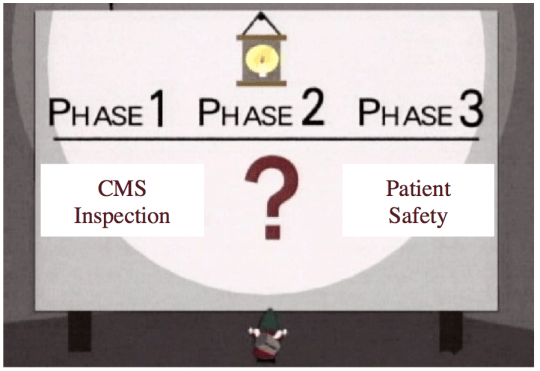
I've recently heard of a scenario in healthcare that I suspect is pretty common, or at least it's not the first time I've heard of this scenario.
There have been stories in the news, but without naming names and without any inside information, here is what is reported to have happened in one of these recent cases:
1) Hospital brings attention on itself by performing a wrong-site surgery on a patient
2) A state-level agency comes in to inspect the situation and finds a number of other problems, including shockingly unsanitary cleaning practices in the O.R., expired medications, and things the state rightfully recognizes to put patients in jeopardy
Right now, this begs the question of whether these SAME problems don't also exist at other hospitals. There might be risks to patients even if there has NOT been a recent wrong-site surgery.
3) The hospital now gets the attention of CMS, from a federal level, and is threatened with losing all Medicare and Medicaid funding if they don't clean up their act
4) There's, apparently, a big scramble to “fix” the problems from step 2
5) The hospital passes a follow-up CMS inspection, things are deemed safe, and the funding will continue
There seem to be at least a few lessons learned, including
a) The government inspectors cannot proactively keep you safe. They can only threaten to punish people who have egregiously bad practices.
b) If the hospital were to lose its CMS funding, thousands of front-line workers might, through no real fault of their own, lose their jobs. The problems described in inspection reports like these are almost always “system problems” that trace back to a lack of good management and a lack of leadership.
c) Front-line staff members and surgeons get suspended or fired, but senior leaders never do, even when there are really embarrassing situations that happened under their watch. It's sure easy for leaders to get away with throwing individuals under the bus.
It also begs the question of “How do we know things will be safe in the future after that follow up inspection?“
I'm sure the state and federal inspectors are well intended and I'll grant that they want to keep patients safe. But, do their methods work? Why do they think they can inspect quality into a process when we know that doesn't work.
It reminds me a bit of the famous “underpants gnomes” from the TV show South Park… who didn't understand the connection between “Phase 1: Collect Underpants” and “Phase 3: Profit.” The poor little gnomes couldn't answer the kids' questions about how exactly they made money collecting underpants. But, they sure were happily busy in their daily work.
I've modified a diagram from the show a bit here… what the gnomes used to try to explain their business model. Phase 2 was “we don't know” with a shrug. But, they were convinced profits were sure to follow (this is a great Lean Startup-related tale, as well).

Phase 2 was likely a one-time “all hands on deck” clean up job.
Let's have a huge sweep to make sure all of the expired medications are gone. Good, patients are safe TODAY.
What has been put in place to make sure there won't be expired medications present in the future??
Do we understand why that problem was there in the first place?
Can we answer that question without blaming our front-line staff?
The same questions could be asked about the other scenarios.
If there were supposedly processes and procedures in place to PREVENT a wrong-site surgery (and they weren't followed or weren't effective, leading to a wrong-site surgery), why does CMS now feel confident that there are policies and procedures in place to protect patients in the future? What is the plan to make sure these errors are truly a “never event” instead of a “rare event”?
Never events are:
the “kind of mistake that should never happen”
But they do. I'm going to call these “so-called never events” until the problem is fixed, I think.
I wonder if CMS will come back to this hospital in 30, 60, or 90 days to see if things are still safe or if they've drifted back to the old ways.
What if they came back even just one week later, for a surprise inspection?
What would they see if they randomly showed up to inspect a random hospital?
This was true back in manufacturing and it's still true today in healthcare — ANYBODY can rally the troops to make things look good when there's a KNOWN inspection visit coming.
I'm reminded of an expression I learned from a British friend:
“The queen thinks the world smells like fresh paint”
And Joint Commission inspectors think nothing is ever stored in hospital hallways, I'm sure.
Please scroll down (or click) to post a comment. Connect with me on LinkedIn.
Let’s build a culture of continuous improvement and psychological safety—together. If you're a leader aiming for lasting change (not just more projects), I help organizations:
- Engage people at all levels in sustainable improvement
- Shift from fear of mistakes to learning from them
- Apply Lean thinking in practical, people-centered ways
Interested in coaching or a keynote talk? Let’s talk.
Join me for a Lean Healthcare Accelerator Trip to Japan! Learn More










I think it was in one of Pascal Dennis’ books where he
points out that most (all) failures have one these causes: a.
Inadequate standard b. Inadequate adherence to standard c.
Inadequate system a. and c. are the responsibility of senior
leaders and are the most frequent causes of failures in my mind,
but senior leaders almost always use b. as the cause, so as you
point out, senior leaders most often get a pass on patient safety
problems. One noted Lean hospital I recently visited has what I
consider to be fail-safe process to avoid two of the failures cited
in your blog, wrong-site surgery and expired supplies. Both of
these “systems” took a lot of time and energy to put in place,
which in my mind shows respect for patients and employees.
Perhaps you need to take some time to know a few Joint Commission staff members before you make a blanket comment on their understanding of how hospitals work. Or is that level of respect or understanding not included in your definition of Lean?
I don’t think it is disrespectful to make a tongue in cheek comment about how hospitals prepare for Joint Commission inspections and don’t exactly present an accurate portrayal of how their hospital normally looks.
Is be curious to hear the Joint Commission’s view on how they are making sure accreditation inspections are more effective and that hospitals aren’t pulling the wool over inspectors’ eyes.
I want this whole process to be more effective because the ultimate disrespect is harming patients.
Every industry has its inspectors who swoop down on a target to look around and check. But other industries that employ inspectors–like Toyota, like the airlines–do not rely on inspectors to “produce” quality. Quality cannot be inspected in.
The inspectors do their jobs well and honorably. But like the nurses and housekeepers in the hospital, inspectors are stuck in a flawed system that disrespects their jobs and their efforts. And as this important post points out, the flawed system is designed to hide underlying problems that need to be brought to light, fixed, and then continuously improved upon.
Why is it so important to fix these problems to root cause? Why ask why? Oh yeah, there’s a patient here!
I took Mark’s comments to be more critical of the hospitals where there is a culture of only meeting certain standards around inspection time. Why shouldn’t hospitals be compliant every day?
@Anonymous – I see two problems:
1) Poor management systems in hospitals (and poor leadership), where they view Joint Commission visits or other inspections (like CAP for the lab) as a thing to prepare for every two years (either taken semi-seriously or as a joke) instead of being ready EVERY DAY, as they should be.
2) I also found the planned/scheduled audit/review/accreditation visit process. I think for these approaches to be at all effective, they need to be unpredictable and unannounced.
If The Joint Commission is doing more of this (less predictable visits), I’m prepared to learn more and stand corrected.
Two comments from LinkedIn:
Kaiya Iverson, CSCP, SSBB*, LBC:
Very true in a great many arenas. Many times has there been a scramble to ready the parade route.
Larry Stetz:
“The Queen thinks the world smells like fresh paint.” I love it! And how true it is. I’ve been in military organizations that prepped for months for an inspection, did great on the inspection, but 2 months later…if the inspectors had returned unannounced…it might not have been so pretty.
From the Joint Commission website:
So, in theory, this sounds great. But hospitals I work with always seem to know when to go through that artificial prep activity of clearing the hallways, etc…
One other citation:
“Corridor clutter remains one of the Joint Commissions’ top cited standards. Indeed, over 45 percent of hospitals receive an “Insufficient Compliance” rating related to storage in the corridor.”
On an average random day, I bet the percentage of non-compliant hospitals is probably more like 90%.
Comments are closed.